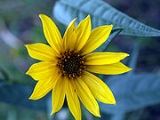
Helianthus maximiliani
Encyclopedia
Helianthus maximiliani (also, H. maximilianii) is a species of sunflower
known by the common name Maximilian sunflower.
Native to much of the eastern half of North America, it is found in parts of the western half as an introduced species
. The plant thrives in a number of ecosystems, particularly across the plains in central Canada and the United States. It is also cultivated as an ornamental
.
A branching perennial herb, growing from a stout rhizome
and reaches heights from one half to three meters. The lance-shaped leaves are narrow, pointed, folded down the midvein, and up to 30 centimeters long on large plants. The slender, tall, erect stems and alternately-arranged leaves are covered in rough hairs. The flower heads
are surrounded at the base by pointed green phyllaries
which often stick straight out and curl at the tips. The center is filled with yellow tipped brown disc florets and the circumference is lined with bright yellow ray florets 2 to 4 centimeters long.
The plant reproduces by seed and by vegetative
sprouting from the rhizome. The thick rhizome is edible and provided a food similar to the Jerusalem artichoke
for Native American groups such as the Sioux
. The flower heads are attractive to insects and the fruits are eaten by birds. This sunflower is named for Prince Maximilian of Wied-Neuwied
, who encountered it on his travels in North America.
Helianthus
Helianthus L. is a genus of plants comprising 52 species in the Asteraceae family, all of which are native to North America, with some species Helianthus L. is a genus of plants comprising 52 species in the Asteraceae family, all of which are native to North America, with some species Helianthus...
known by the common name Maximilian sunflower.
Native to much of the eastern half of North America, it is found in parts of the western half as an introduced species
Introduced species
An introduced species — or neozoon, alien, exotic, non-indigenous, or non-native species, or simply an introduction, is a species living outside its indigenous or native distributional range, and has arrived in an ecosystem or plant community by human activity, either deliberate or accidental...
. The plant thrives in a number of ecosystems, particularly across the plains in central Canada and the United States. It is also cultivated as an ornamental
Ornamental plant
Ornamental plants are plants that are grown for decorative purposes in gardens and landscape design projects, as house plants, for cut flowers and specimen display...
.
A branching perennial herb, growing from a stout rhizome
Rhizome
In botany and dendrology, a rhizome is a characteristically horizontal stem of a plant that is usually found underground, often sending out roots and shoots from its nodes...
and reaches heights from one half to three meters. The lance-shaped leaves are narrow, pointed, folded down the midvein, and up to 30 centimeters long on large plants. The slender, tall, erect stems and alternately-arranged leaves are covered in rough hairs. The flower heads
Head (botany)
The capitulum is considered the most derived form of inflorescence. Flower heads found outside Asteraceae show lesser degrees of specialization....
are surrounded at the base by pointed green phyllaries
Bract
In botany, a bract is a modified or specialized leaf, especially one associated with a reproductive structure such as a flower, inflorescence axis, or cone scale. Bracts are often different from foliage leaves. They may be smaller, larger, or of a different color, shape, or texture...
which often stick straight out and curl at the tips. The center is filled with yellow tipped brown disc florets and the circumference is lined with bright yellow ray florets 2 to 4 centimeters long.
The plant reproduces by seed and by vegetative
Vegetative reproduction
Vegetative reproduction is a form of asexual reproduction in plants. It is a process by which new individuals arise without production of seeds or spores...
sprouting from the rhizome. The thick rhizome is edible and provided a food similar to the Jerusalem artichoke
Jerusalem artichoke
The Jerusalem artichoke , also called the sunroot, sunchoke, earth apple or topinambour, is a species of sunflower native to eastern North America, and found from Eastern Canada and Maine west to North Dakota, and south to northern Florida and Texas...
for Native American groups such as the Sioux
Sioux
The Sioux are Native American and First Nations people in North America. The term can refer to any ethnic group within the Great Sioux Nation or any of the nation's many language dialects...
. The flower heads are attractive to insects and the fruits are eaten by birds. This sunflower is named for Prince Maximilian of Wied-Neuwied
Prince Maximilian of Wied-Neuwied
Prince Alexander Philipp Maximilian zu Wied-Neuwied was a German explorer, ethnologist and naturalist....
, who encountered it on his travels in North America.

